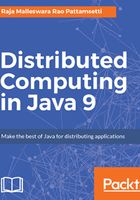
Preface
Distributed computing is a way of improving the system processing ability by splitting and sharing the effort with multiple smaller systems and collating the results from them to get the desired process output. In this book, we have tried our best to put together the concepts of distributed computing, from the thought they started and how trends have changed from single-computer processing to modern distributed computing on cloud portfolio.
While we describe each of the concepts with detailed explanations and handy diagrams that rightly represent the systems and flows, we bring appropriate examples and code snippets to help you understand how they can be implemented with the help of Java 9.
There are numerous improvements to the concepts, and additional features have enriched Java’s ability to support distributed computing in Java 9. We have discussed the era of distributed computing along with latest improvements and application in Java 9 through the separate chapters. This should cover the design thoughts and security aspects as well, which, we believe, lets you concentrate on that specific topic and understand it a step further with the right combination of explanation, diagrams, and code snippets.
This book took about 6 months for me to write, and it was a great journey. The design and development experiences with multiple enterprise integrations and distributed systems with the support of solution architecture teams helped me go through the on-ground challenges and improve the design standpoint of system integration. You will see in multiple places that I start talking about design perspectives and patterns before the solution implementation specifics. Also, care has been taken to help you with the concepts in such a way that you should feel like being part of a detailed technical conversation right from the start, where your knowledge and past skillset help you go through them and improve along the depth of the chapters.
Most concepts are imbued with an everlasting perception of reusability and thorough engineering, and I believe some parts of this will remain with you, being the reader, as useful techniques to reuse in your application development.
Finally, while I have made sure to complement every chapter with several images to illustrate the desired output, I think it is paramount for you to review every concept along with practice, which helps you learn and build confidence in working with such systems.
Have fun building great things!